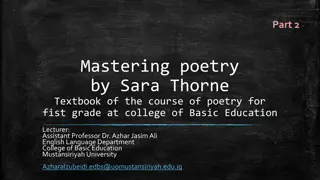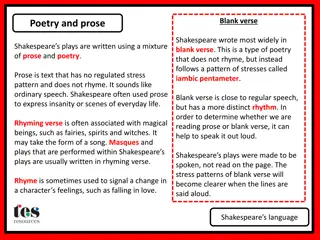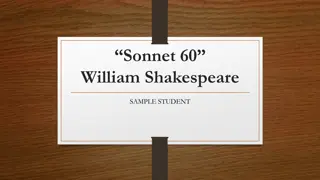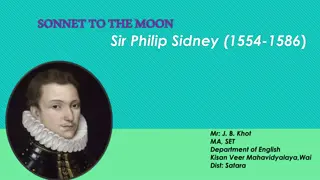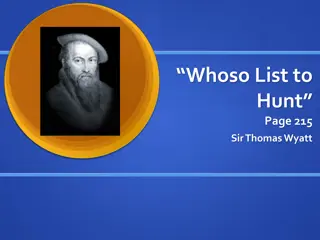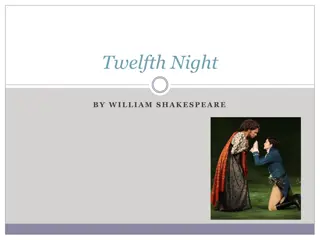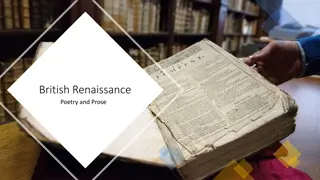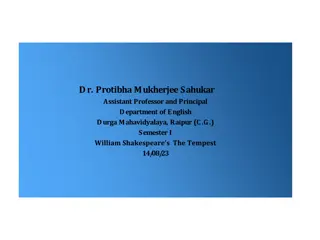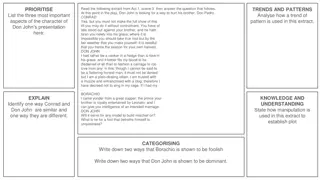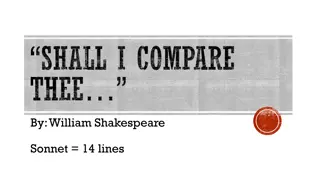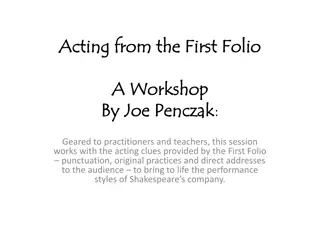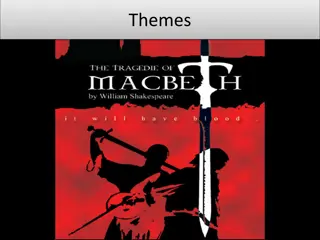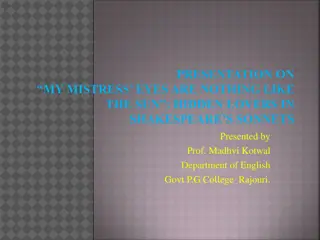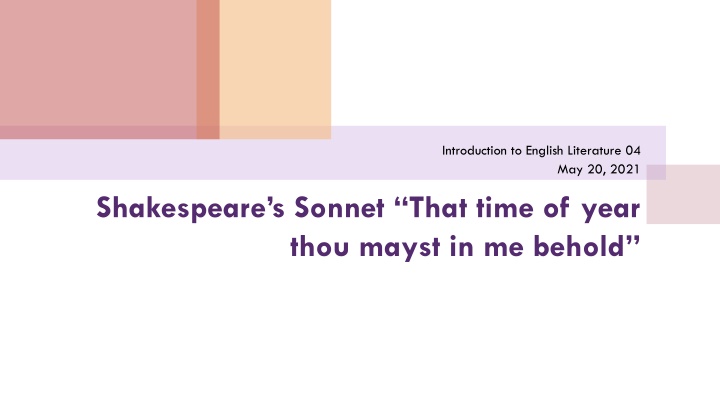
Visualizing Metaphors: Understanding Shakespeare's Literature
Explore the use of metaphors in English literature, focusing on Shakespeare's sonnets and biographical information. Understand how metaphors enhance visual imagery and convey deeper meanings in literary works. Delve into the life and significance of William Shakespeare, a revered figure in English literature.
Download Presentation

Please find below an Image/Link to download the presentation.
The content on the website is provided AS IS for your information and personal use only. It may not be sold, licensed, or shared on other websites without obtaining consent from the author. If you encounter any issues during the download, it is possible that the publisher has removed the file from their server.
You are allowed to download the files provided on this website for personal or commercial use, subject to the condition that they are used lawfully. All files are the property of their respective owners.
The content on the website is provided AS IS for your information and personal use only. It may not be sold, licensed, or shared on other websites without obtaining consent from the author.
E N D
Presentation Transcript
Introduction to English Literature 04 May 20, 2021 Shakespeare s Sonnet That time of year thou mayst in me behold
Metaphor I Being visual does not just mean describing; telling us facts; indicating shapes, colors, and specific details. Often the vividness of the picture in our minds depends on comparisons made through figures of speech. What we are trying to imagine is pictured in terms of something else familiar to us, and we are asked to think of one thing as if it were something else. Many such comparisons, in which something is pictured or figured forth in terms of something already familiar to us, are taken for granted in daily life. Things we can t see or that aren t familiar to us are imaged as things we already know; for example, God is said to be like a father; Italy is said to be shaped like a boot; life is compared to a forest, a journey, or a sea. When the comparison is implicit, describing something as if it were something else, it is called a metaphor.
Metaphor II The most important and widespread *FIGURE OF SPEECH in which one thing, idea or action is referred to by a word or expression normally denoting another thing, idea, or action, so as to suggest common quality shared by the two. In metaphor, this resemblance is assumed as an imaginary identity rather than directly stated as a comparison... Modern analysis of metaphors and similes distinguishes the primary literal term(called TENOR ) from the secondary figurative term (the vehicle ) applied to it: in the metaphor the road of life, the tenor is life, and the vehicle is the road. (From the Concise Oxford Dictionary of Literary Terms)
Shakespeares Biography I William Shakespeare is the most widely admired and respected writer in the English language. He is as significant a literary figure as the great writers of antiquity: Homer, Plato, Virgil. Only a handful of 'modern' authors can feasibly be seen as his equal: Dante, Cervantes, Moli re, Tolstoy.
Shakespeares Biography II Shakespeare in his own lifetime was just one of a number of talented playwrights operating in London between 1580 and 1610. Few documents relating to Shakespeare's life survive and no clear indication of his personality and temperament. Because of this elusive quality, some writers and critics have suggested that Shakespeare did not actually exist. some critics have responded to this by saying that this 'one man' was not Shakespeare, but Francis Bacon or Christopher Marlowe.
Shakespeares Biography III born in April 1564, baptised on 26th April at the Holy Trinity Church, Stratford-upon-Avon. His father, John Shakespeare, had moved to Stratford in 1552, and by the time of Shakespeare's birth, he was a successful businessman, specialising in making and selling gloves. In the 1560s, John Shakespeare became an active municipal politician, serving as chamberlain (1561), alderman (1565) and mayor (1568).
Shakespeares Biography IV The next significant fact that is known about Shakespeare concerns Anne Hathaway, a woman eight years his senior. She became pregnant by him in the summer of 1582 and a 'shotgun' wedding was arranged in November 1582. Their daughter Susannah was born in May 1583. Most critics seem to agree that Shakespeare and Anne Hathaway did not have a particularly close or happy marriage. They had only two more children (twins called Hamnet and Judith) and they spent few of the next thirty years together. In his will, Shakespeare famously left Anne his 'second-best bed'. However, outwardly, he provided well for his wife and children.
Shakespeare's Work Shakespeare's works include 38 plays, 2 narrative poems, 154 sonnets, and a variety of other poems. No original manuscripts of Shakespeare's plays are known to exist today. It is actually thanks to a group of actors from Shakespeare's company that we have about half of the plays at all. They collected them for publication after Shakespeare died, preserving the plays. These writings were brought together in what is known as the First Folio(1623) ('Folio' refers to the size of the paper used). It contained 36 of his plays, but none of his poetry.
Shakespeare Sonnet no. 73: That time of year thou mayst in me behold I That time of year thou mayst in me behold When yellow leaves, or none, or few, do hang Upon those boughs which shake against the cold, Bare ruined choirs, where late the sweet birds sang. . , .
Shakespeare Sonnet no. 73: That time of year thou mayst in me behold II In me thou see st the twilight of such day As after sunset fadeth in the west; Which by and by black night doth take away, Death s second self, that seals up all in rest. . ( ) . ( ) .
Shakespeare Sonnet no. 73: That time of year thou mayst in me behold III In me thou see st the glowing of such fire, That on the ashes of his youth doth lie, As the deathbed whereon it must expire, Consumed with that which it was nourished by. . , ( ) , . ( ) ( ) ( ) .
Shakespeare Sonnet no. 73: That time of year thou mayst in me behold IV This thou perceiv st, which makes thy love more strong, To love that well which thou must leave ere long. , , .
Metaphor in the Poem The first four lines of "That time of year" evoke images of the late autumn, but notice that the poet does not have the speaker say directly that his physical condition and age make him resemble autumn. He draws the comparison without stating it as a comparison: You can see my own state, he says, in the coming of winter, when almost all the leaves have fallen from the trees. The speaker portrays himself indirectly by talking about the passing of the year. The poem uses metaphor; that is, one thing is pictured as if it were something else. That time of year goes on to another metaphor in lines 5 8 and still another in lines 9 12, and each metaphor contributes to our understanding of the speaker s sense of his old age and approaching death. More important, however, is the way the metaphors give us feelings, an emotional sense of the speaker s age and of his own attitude toward aging. Through the metaphors we come to understand, appreciate, and to some extent share the increasing sense of urgency that the poem expresses. Our emotional sense of the poem depends largely on the way each metaphor is developed and by the way each metaphor leads, with its own kind of internal logic, to another, even as later metaphors build on earlier ones. Look back at the poem. What does each metaphor contribute? That time of year represents an unusually intricate use of images to organize a poem and focus its emotional impact. (490-91/837-38)




